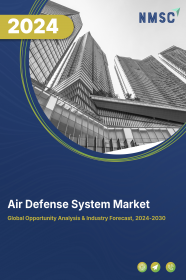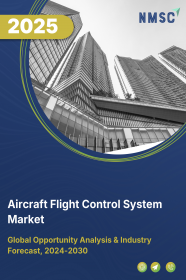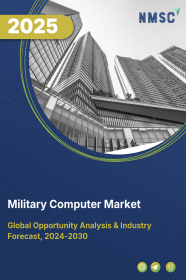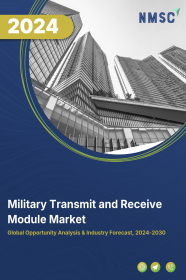
Air Defense System Market by Component (Weapon System, Fire Control System, Command and Control System), by Type (Missile Defense System, Anti-Aircraft System, C-Ram System, and Counter Unmanned Aerial Systems (C-UAS)), by Platform (Land-based, Air-based, and Sea-based), and by Range (Long-range Air Defense System, Medium-range Air Defense System, and Short-range Air Defense System) - Global Opportunity Analysis and Industry Forecast 2024-2030
US Tariff Impact on Air Defense System Market
Trump Tariffs Are Reshaping Global Business
Market Definition
The Air Defense System Market size was valued at 43.41 billion in 2023 and is predicted to reach 62.23 billion by 2030 with a CAGR of 5.2% from 2024-2030. An Air Defense System is a military system designed to detect, track, intercept, and neutralize threats posed by enemy aircraft, missiles, or other aerial threats. These systems utilize complex network of technologies, equipment, and procedures designed to protect against aerial threats, including enemy aircraft, missiles, and drones. These systems are essential for maintaining security and safeguarding critical assets such as military installations, infrastructure, and populated areas. Air defense systems employ advanced radar systems, surface-to-air missiles, anti-aircraft artillery, and command and control centers to detect, track, and neutralize airborne threats effectively, playing a crucial role in national defense and security strategies worldwide.
Market Dynamics and Trends
The increasing incidents of terrorism activities worldwide are fueling the expansion of the air defense system market. According to the latest report from the Global Terrorism Index, in 2023, more than 8,000 fatalities resulting from terrorist attacks, marking the highest level since 2017. With this alarming rise in the global terrorist threat landscape, the demand for advanced air defense systems continues to escalate, driving the growth of the market.
Moreover, heightened geopolitical tensions and regional conflicts around the world are compelling countries to invest in resilient air defense capabilities, further boosting the market expansion. As nations prioritize the enhancement of their defense systems to safeguard their territories and address evolving security challenges, the demand for advanced air defense technologies continues to rise to ensure national security and stability within a volatile global landscape.
However, the high cost of development, procurement, and maintenance of advanced air defense systems, along with export controls and regulations imposed by countries on sensitive defense technologies restrains the growth of the market. On the contrary, advancement in technologies such as radar technology, missile guidance systems, and sensor fusion are anticipated to create numerous opportunities in the growth of the market in the coming years. These technologies are anticipated to enhance the capabilities of air defense systems, enabling more precise detection, tracking, and interception of aerial threats.
Market Segmentations and Scope of the Study
The air defense system market is segmented on the basis of component, type, platform, range, and region. Based on component, the market is classified into weapon system, fire control system, command and control system. On the basis of type, the market is segmented into missile defense system, anti-aircraft system, c-ram system, and counter unmanned aerial systems (C-UAS). Based on platform, the market is divided into land-based, air-based, and sea-based. On the basis of range, the market is classified into Long-range air defense system, medium-range air defense system, and short-range air defense system. Regional breakdown and analysis of each of the aforesaid segments includes regions comprising of North America, Europe, Asia-Pacific, and RoW.
Geographical Analysis
North America holds the dominant share of the drone countermeasures market and is expected to continue its dominance during the forecast period. This is due to the growing investment in air defense system by the military and homeland security agencies in countries such as the U.S. and Canada. According to the Department of Defense, the U.S. government allocated USD 668 million for air defense research and development and USD 78 million for counter-unmanned aerial vehicle (C-UAV/ C-UAS) procurement in 2023. These significant investments underscore the region's commitment to enhancing its air defense capabilities, driving the growth of the market in North America.
Moreover, the presence of key players such as Lockheed Martin Corporation, Northrop Grumman Corporation, and The Boeing Company plays a major role in the growth of the air-defense system market in this region. For instance, in November 2023, Lockheed Martin Corporation invested USD 16.5 million for the construction of a new air defense system facility in the U.S. The expansion was aimed towards the development, testing, and system integration for long range ballistic missile defense interceptor – the Next Generation Interceptor (NGI) for the U.S. Missile Defense Agency (MDA).
On the other hand, Asia Pacific is expected to show a steady rise in the development of the air defense system market due to the the increasing military and defense expenditures of major countries such as China, India, and South Korea. According to the World Bank, China's military expenditure reached USD 293.35 billion in the fiscal year 2021-22 to strengthening its defense capabilities. As countries in the Asia Pacific region prioritize modernizing their military forces to address evolving security challenges, the market for air defense systems is poised for significant expansion.
Moreover, the rising terrorism and criminal activities in the region is further driving the adoption of anti-drone technology. For example, in March 2024, the Indian Army deployed seven new indigenous integrated drone detection and interdiction systems (IDD&IS) developed by DRDO. These vehicle-based systems provide comprehensive defense against hostile drones, offering both "soft kills" through jamming and "hard kills" using lasers, safeguarding critical infrastructure and public safety against potential security breaches.
Competitive Landscape
The air defense system market comprising of various market players such as Raytheon Company, Northrop Grumman Corporation, Vertex Aerospace, SAAB AB, Israel Aerospace Industries Ltd., Lockheed Martin Corporation, Leonardo S.P.A., Bae Systems PLC, Hanwha Corporation, Thales Group, The Boeing Company, Rheinmetall AG, MBDA, Aselsan A.S., Kongsberg Gruppen, and others. These market players are adopting various joint venture strategies and planning expansion of business across various regions to maintain their dominance in the air defense system market.
For instance, in March 2024, Northrop Grumman Corporation collaborated with Diehl Defence GmbH & Co. KG to work together to support innovative layered air and missile defense capabilities for Germany. The collaboration was aimed toward utilizing the companies advanced technologies such as Integrated Battle Command System (IBCS) of Northrop and IRIS-T SLM of Diehl for the development of advanced air defense system. Moreover, in December 2023, Thales Group launched the air defense system named GROUND MASTER 400Α long range radar. Through this launch, the company aims to enhamcethe air defense security of Royal Malaysian Air Force.
KEY BENEFITS
-
The report provides quantitative analysis and estimations of Air Defense System Market from 2024 to 2030, which assists in identifying the prevailing market opportunities.
-
The study comprises a deep dive analysis of the Air Defense System Market including the current and future trends to depict prevalent investment pockets in the market.
-
Information related to key drivers, restraints, and opportunities and their impact on the Air Defense System Market is provided in the report.
-
Competitive analysis of the players, along with their market share is provided in the report.
-
SWOT analysis and Porters Five Forces model is elaborated in the study.
-
Value chain analysis in the market study provides a clear picture of roles of stakeholders.
KEY MARKET SEGMENTS
By Component
-
Weapon System
-
Fire Control System
-
Command and Control System
By Type
-
Missile Defense System
-
Anti-Aircraft System
-
C-Ram System
-
Counter Unmanned Aerial Systems (C-UAS)
By Platform
-
Land-based
-
Air-based
-
Sea-based
By Range
-
Long-range Air Defense System
-
Medium-range Air Defense System
-
Short-range Air Defense System
By Region
-
North America
-
The U.S.
-
Canada
-
Mexico
-
-
Europe
-
The UK
-
Germany
-
France
-
Italy
-
Spain
-
Denmark
-
Netherlands
-
Finland
-
Sweden
-
Norway
-
Russia
-
Rest of Europe
-
-
Asia Pacific
-
China
-
Japan
-
India
-
South Korea
-
Australia
-
Indonesia
-
Singapore
-
Taiwan
-
Thailand
-
Rest of Asia Pacific
-
-
RoW
-
Latin America
-
Middle East
-
Africa
-
REPORT SCOPE AND SEGMENTATION:
|
Parameters |
Details |
|
Market Size in 2023 |
USD 43.41 Billion |
|
Revenue Forecast in 2030 |
USD 62.23 Billion |
|
Growth Rate |
CAGR of 5.2% from 2024 to 2030 |
|
Analysis Period |
2023–2030 |
|
Base Year Considered |
2023 |
|
Forecast Period |
2024–2030 |
|
Market Size Estimation |
Billion (USD) |
|
Growth Factors |
|
|
Countries Covered |
28 |
|
Companies Profiled |
15 |
|
Market Share |
Available for 10 companies |
|
Customization Scope |
Free customization (equivalent up to 80 working hours of analysts) after purchase. Addition or alteration to country, regional, and segment scope. |
|
Pricing and Purchase Options |
Avail customized purchase options to meet your exact research needs. |
KEY PLAYERS
-
Raytheon Company
-
Northrop Grumman Corporation
-
SAAB AB
-
Israel Aerospace Industries Ltd.
-
Vertex Aerospace
-
Lockheed Martin Corporation
-
Leonardo S.P.A.
-
Bae Systems PLC
-
Hanwha Corporation,
-
Thales Group
-
The Boeing Company
-
Rheinmetall AG
-
MBDA
-
Aselsan A.S.
-
Kongsberg Gruppen

















 Speak to Our Analyst
Speak to Our Analyst




















